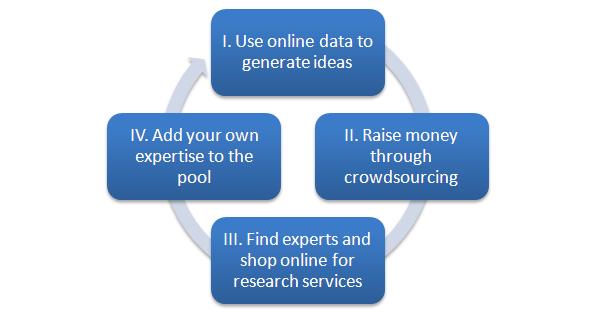A new paradigm for drug discovery: part four – the evolving publishing space in the information age

In the final part of our series on the changing face of Life Science research, Dr Kevin Lustig and Dr Maria Thompson discuss how the information age has enabled scientists to publish their findings and make their data available online for others to use.
The final installment of our series brings us full circle and details how scientists can publish electronically, and contribute their own raw data back into the knowledge pool.
Part 1 of this series discussed how the growing amount of raw scientific data now available online makes it possible for scientists to undertake truly groundbreaking research without a laboratory. A new diagnostic test for cancer can be developed without doing any wet lab work whatsoever; simply by mining the existing pool of data from experiments others have done. For this 'Big Data' approach to succeed, it is important that all scientists ensure that new data they generate also finds its way back into the collective knowledge pool.
Ever since King Charles II in 1662 granted the Royal Society of London a charter to publish, scientists have been publishing their work in peer-reviewed publications. Scientific papers are reviewed by expert reviewers prior to acceptance and typically take 6 to 18 months to be published. The Internet and social media, however, have given rise to a radically different way of disseminating research results. Today, scientists can publish non peer-reviewed material immediately online. Even with peer-reviewed journals, there are now more options than ever before.
Options for non peer-reviewed publication
Websites and blogs are definitely the fastest way to get scientific data out there. Social media and the ability of people to comment and discuss immediately are one of the greatest benefits of this mode of publication. In fact, website owners are publishers in their own rights and have the means to disseminate data and results as they see fit. While this method of publication is certainly gaining in popularity, it has yet to gain the respectability of the peer review process.
"A peer-reviewed publication with follow-up blogs about the work is probably the best approach as it leads to the widest audience being reached."
In academia, it is especially true that you must publish or perish, and online blogs and websites are still not an accepted method of publishing for most scientists. Why? Blog and website publishing surely suffice as avenues to fulfill the main purpose of publishing: to present new and original results and methods, to exchange ideas, and to communicate with peers. Blogs and open websites, however, do not satisfy the other reasons as to why scientists publish – grant funding, credibility, recognition and career advancement.
When a scientist publishes their work on a blog or website, Google does index the work and allows it to appear in Google search results. However, blogs and websites are not indexed by sites such as Pubmed and Google Scholar, which index and abstract peer-reviewed publications. This simple fact greatly limits the exposure of a traditional research scientist to non peer-reviewed research results.
A peer-reviewed publication with follow-up blogs about the work is probably the best approach as it leads to the widest audience being reached.
Options for peer-reviewed publication
For centuries, scientists have published their work in peer-reviewed scientific journals. Many scientists over 35 will remember the days of going to the basement of a library and trawling through an abstract index looking for relevant articles.
With Google Scholar and Pubmed, and other online indexing sites, a scientist today has the ability to stay on top of scientific publications with automated searches for keywords relevant to their research interests.
"Many of us have already experienced the problem of wanting to read an article from a journal that their employer or academic institution does not pay to access."
Although many mainstream journals, including titans such as Nature and Science, accept manuscripts for free, publishing with them is still such a lengthy procedure and even then, this often comes at a price, with the reader needing to pay for access to read the full publication.
Many of us have already experienced the problem of wanting to read an article from a journal that their employer or academic institution does not pay to access. The abstract can be viewed but full access to the entire article can't be obtained without paying a fee. This is not too big a problem if the scientist works for a large organization with deep pockets, but for an academic scientist at a small institution or a citizen scientist working on her own, the costs are prohibitive. There are ways to access articles via community libraries but doing so can slow progress down to a crawl. If a researcher is working in a developing nation they are often simply out of luck.
Considering that most academic research is funded by government grants, it seems reasonable to expect that taxpayer-funded academic research results are made available to anyone who wants access to them. Over the last several years, there has been a dramatic increase in the number of such 'open access' journals. These distinguish themselves from their long-standing 'restricted access' brethren by making their content freely available to anyone who wants to read it.
Fees
It is important to note that with open access journals somebody still has to pay the bills. The so-called 'fee free' journals are often funded by universities and government institutions. The fee-based journals also typically require a fee from the author; this fee is normally paid out of the research grant that funded the work. For an independent or citizen scientist working on their own, or an underfunded academic researcher, most of the open access journals enable them to request a reduction or elimination of the publication fees. The open access journals take pains to ensure that neither the peer reviewers nor the editor selecting articles for publication are aware which articles have applied for or been granted a reduction in fees.
"Some scientists believe that impact factor no longer carries as much weight as it used to..."
Impact
In the past, impact factor was a major consideration for an author looking for a publication. Some of the free access journals have now been around long enough that they are starting to be ranked for impact. While the traditional restricted access journals still dominate the top end of the scale, there has definitely been a groundswell of support for publication of quality research in PLOS and other high quality open access journals.
Some scientists believe that impact factor no longer carries as much weight as it used to and it's certainly not as "black and white" as it used to be. A scientist researching malaria might choose to publish in an open-access journal known to reach the desired audience in Africa rather than a high ranking journal with more restrictive access.
The journals
Below we list four open access journals worth considering in the biological / chemical / pharmaceutical space. A full list of open access journals indexed by topic can be found at Directory of Open Access Journals (DOAJ) and Open J-Gate. When considering where to publish your work you should review the full list available at either of the two sites listed above. Good luck!
• PLoS one (Impact factor 4.4). One of the largest of the open access journals, accepts topics on a broad range of topics. (see also PLoS Biology, and PLoS Medicine)
• International Journal of Biological sciences. (Impact factor 2.69). Accepts articles on general biological topics.
• Biomedcentral. (Impact factor depends on the specific journal.) Publishes on a variety of topics relevant to drug discovery.
• BMC Medicine. (Impact factor 5.75) Part of the Biomedcentral group listed above. Focused on medical publications, scores in the top 10% of all general medical journals.
About the authors:
Kevin Lustig is co-founder and CEO of Assay Depot, the world's largest online marketplace for scientific services. In 2001, he founded Kalypsys, a drug discovery company that raised over $170 million in venture capital. Prior to this, he directed lead discovery at Tularik, a biopharmaceutical company purchased by Amgen in 2004 for $2.5 billion. Kevin has over 30 years of research experience including a postdoc at Harvard Medical School and a PhD degree in biochemistry from UCSF. His research discoveries have been published in Science and Nature magazines and he has been awarded eight technology patents. Dr Lustig can be contacted at klustig@assaydepot.com and more information about Assay Depot can be found at www.assaydepot.com
Dr Maria Thompson is a molecular biologist with over 16 years of experience in research and development for pharmaceuticals and diagnostics. Over this period she has held a variety of leadership positions including Head of Genome Wide Screening for Type 2 diabetes, Six Sigma Black Belt, and VP of Scientific Affairs. Dr Thompson is currently Principal Consultant at APEX think, a niche consulting company providing scientific and technical advisory services to clients across the life science industry. Dr Thompson holds a BSc in Genetics and a PhD in Molecular and Cellular Biochemistry from the Royal London School of Medicine, UK. She can be contacted at: consulting.mt@gmail.com or www.APEXthink.com
Do you think peer-reviewed or non peer-reviewed journals are best?













